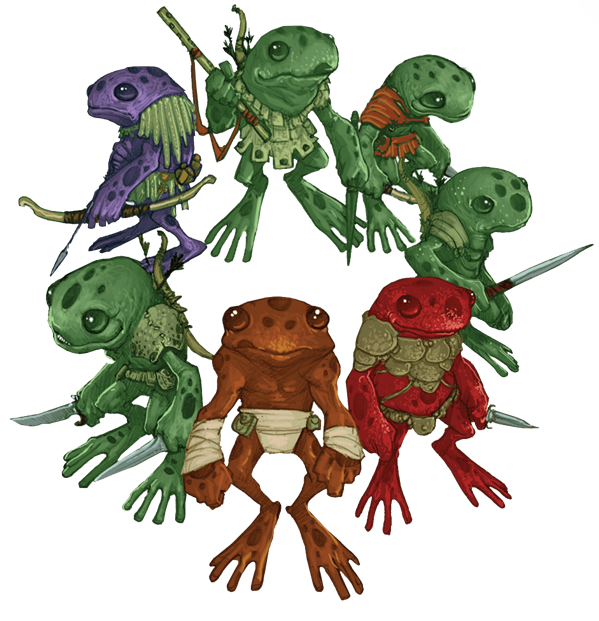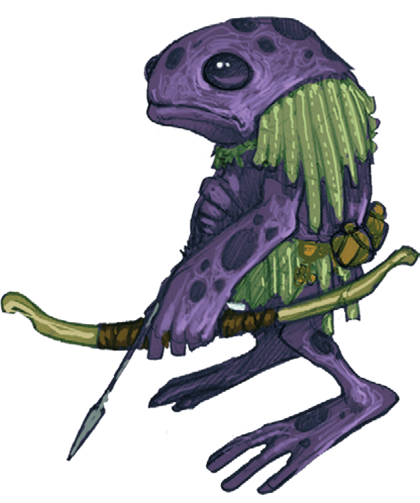Grung
Shadow Kind
Those Grung that find themselves in the Mundane world generally struggle. They are creatures that are used to structure and rigid rules. Outside that, they often have a difficult time functioning. They are poisonous which makes it difficult for them to integrate into other groups. There are no established groups of Grung in the Mundane world which would be required for breeding, thus they are not born here. All the Grung that are in the Mundane world came from the Shadow Realm.Castes and Colors.
Grung society is a caste system. Each caste lays eggs in a separate hatching pool, and juvenile grungs join their caste upon emergence from the hatchery. All grungs are a dull greenish gray when they are born, but each individual takes on the color of its caste as it grows to adulthood. Green grungs are the tribe’s warriors, hunters, and laborers, and blue grungs work as artisans and in other domestic roles. Supervising and guiding both groups are the purple grungs, which serve as administrators and commanders. Red grungs are the tribe’s scholars and magic users. They are superior to purple, blue, and green grungs and given proper respect even by grungs of higher status. Higher castes include orange grungs, which are elite warriors that have authority over all lesser grungs, and gold grungs, which hold the highest leadership positions. A tribe’s sovereign is always a gold grung. A grung normally remains in its caste for life. On rare occasions, an individual that distinguishes itself with great deeds can earn an invitation to join a higher caste. Through a combination of herbal tonics and ritual magic, an elevated grung changes color and is inducted into its new caste in the same way that a juvenile of the caste would be. From then on, the grung and its progeny are members of the higher caste.Slavers.
Grungs are always on the lookout for creatures they can capture and enslave. Grungs use slaves for all manner of menial tasks, but mostly they just like bossing them around. Slaves are fed mildly poisoned food to keep them lethargic and compliant. A creature afflicted in this way over a long period of time becomes a shell of its former self and can be restored to normalcy only by magic.Basic Information
Anatomy
Amphibious
You can breathe air and water.Poison Immunity
You’re immune to poison damage and the poisoned condition.Poisonous Skin
Any creature that grapples you or otherwise comes into direct contact with your skin must succeed on a DC 12 Constitution saving throw or become poisoned for 1 minute. A poisoned creature no longer in direct contact with you can repeat the saving throw at the end of each of its turns, ending the effect on itself on a success. You can also apply this poison to any piercing weapon as part of an attack with that weapon, though when you hit the poison reacts differently. The target must succeed on a DC 12 Constitution saving throw or take 2d4 poison damage.Standing Leap
Your long jump is up to 25 feet and your high jump is up to 15 feet, with or without a running start.Water Dependency
If you fail to immerse yourself in water for at least 1 hour during a day, you suffer one level of exhaustion at the end of that day. You can only recover from this exhaustion through magic or by immersing yourself in water for at least 1 hour.Growth Rate & Stages
About three months after hatching, a grung tadpole takes on the shape of an adult. It takes another six to nine months for a grung juvenile to reach maturity.
Ecology and Habitats
Grungs live in trees and prefer shade. A grung hatchery is maintained in well-guarded ground-level pools.




Comments